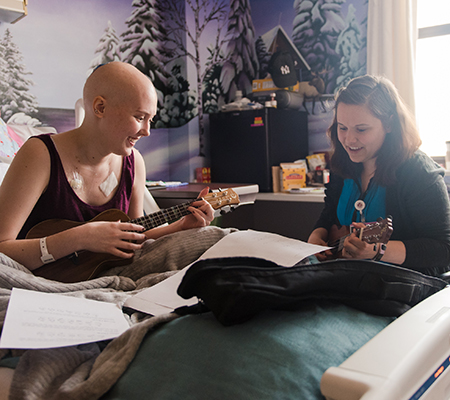
Expressive therapies, like music and art, help children cope with the stress of being in the hospital.
Being in the hospital can be scary, confusing and come with intense emotions, especially for children. Expressive therapy, like music and art, offers a nonthreatening way for children to process emotions and distract from pain.
At Marshfield Children’s Hospital, board-certified music therapists from Child Life and Expressive Therapies work with the child’s care team while developing a therapeutic relationship to create individualized music therapy sessions.
“One of the things we do is to use knowledge of music and the brain to help with pain management,” said Amanda Czarnecki, board-certified music therapist with Marshfield Children’s Hospital. “I often explain to children and their families that if they enjoy playing or listening to music their brains are filled with good feeling hormones that also flood their bodies to help make them feel better.”
Activities serve dual purpose
Music therapists have an undergraduate degree in music therapy, complete a six-month internship and are board-certified. “We’re very lucky to offer services for families for free because of funding from Children’s Miracle Network and Foundation donations,” said Heidi Giese, Child Life and Expressive Therapies manager.
Singing and playing instruments help children increase movement and improve breathing. It also provides an outlet for expression while in the hospital. Children tend to work longer as they play through the song since they are having fun. “Music and its connection with the brain plays a big role in how we use music to reach specific goals,” said Carolann Franke, board-certified music therapist. “For example, we can use rhythm and tempo to help guide breathing or help with movement in rehabilitation.”
Music therapists can work with children using harmonicas as an addition to respiratory therapy. Children breathe in and out, take big breaths and hold notes to enhance respiration. “Using a harmonica does the same thing as a spirometer in a more friendly and fun way. We can help with their medical needs while still allowing the children to play,” Czarnecki said.
There are times they see real-time impact of their work. “It’s rewarding to see principal oxygen levels increase or a blood pressure level out as we work,” Franke said.
For the youngest patients in the neonatal intensive care unit, music therapists can promote sensory stimulation or give comfort by recording mom’s heartbeat to play when the family can’t be there.
Expressive therapy helps children process complex emotions
Music and art also helps children communicate feelings and fears. While there are no trained art therapists at Marshfield Children’s Hospital, staff at New Visions Art Gallery facilitate expressive art activities to help children cope with the stress and unfamiliarity of being in the hospital. These activities give children back some control in their day when their choices are limited.
“Children in hospitals are, first of all, children. They need to play and interact as such even when in the hospital setting,” said Bobbie Erwin, New Visions Gallery director. “Art activities are a great option as they can be adapted to each child’s individual situation. They can be done in a group, in an activity room or bedside, according to the child’s wants and needs.”
Learn more about music and art therapy at Marshfield Children’s Hospital.
Related Shine365 posts
Surgery doesn’t have to be scary for kids


I remember when my 92 yr old mother was dying and she recieved musical therapy in Pallative Care it was like a breath of fresh air for her.
More of that is o need for all patients young and old.